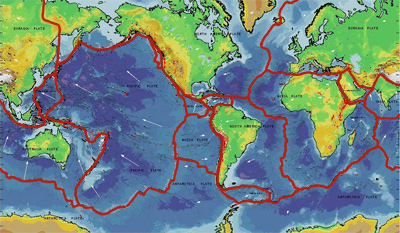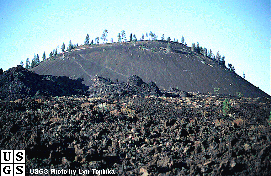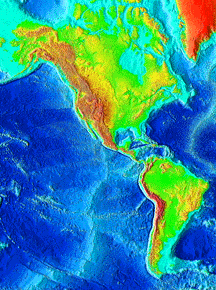This image shows the topography, or shape, of the Earth's surface, on land and below the oceans. Mountain ranges, subduction trenches, tectonic plates, and mid-ocean ridges are all visible in the image.
Click on image for full size
Image from: U.S. Geological Survey
Surface Features of the Earth
This image of the surface of the Earth shows the North and South American continents, as well as the floor of the Pacific Ocean. As can be seen in the image, the ocean floor shows evidence of
The continental regions show evidence of
(Click on the image to see labeled examples of these features.)
These things provide evidence that, unlike other planets, the surface of the Earth is in motion. Motion of the Earth's surface is called plate tectonics.
Compare this active surface with that of Venus, Mars, or Europa.
You might also be interested in:

The Hawaiian Islands are an example of the way some volcanoes are made. A rising hot plume of material makes it's way to the lithosphere of the Earth from the deep interior, and erupts material unto the
...more
When two sections of the Earth's lithosphere collide one slab of lithosphere can be forced back down into the deeper regions of the Earth, as shown in this diagram. This process is called subduction.
...more
Mountains are built through a general process called "deformation" of the crust of the Earth. One example of deformation comes from the process of subduction. When two sections of the Earth's lithosphere
...more
Many forces cause the surface of the Earth to change over time. However, the largest force that changes our planet's surface is the movement of Earth's outer layer through the process of plate tectonics.
...more
Ash is made of millions of tiny fragments of rock and glass formed during a volcanic eruption. Volcanic ash particles are less than 2 mm in size and can be much smaller. Volcanic ash forms in several ways
...more
Cinder cones are simple volcanoes which have a bowl-shaped crater at the summit and rarely rise more than a thousand feet above their surroundings. They usually are created of eruptions from a single vent,
...more
Lava can move in broad flat lava flows, or it can move through constrictive channels or tubes. Lava flows have a large surface area so they tend to cool quickly and flow slowly. The fastest unconstricted
...more















